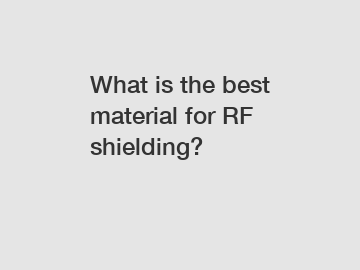What is the best material for RF shielding?
As technology continues to advance, the use of radio frequency (RF) devices and wireless technologies becomes increasingly ubiquitous. While this brings convenience and innovation, it also raises concerns about electromagnetic interference (EMI) and the need for effective RF shielding. Among the key considerations in designing robust RF shielding is the choice of material. In this blog, we delve into the realm of RF shielding materials to uncover the best options that ensure optimal electromagnetic isolation.
1. Understanding RF Shielding:
Before delving into the details of the best materials for RF shielding, let us first establish a foundation by understanding the concept of RF shielding. RF shielding refers to the practice of enclosing an object or space to prevent unwanted electromagnetic radiation from entering or escaping. By effectively blocking these waves, electromagnetic interference can be minimized, ensuring optimal functioning of nearby equipment and systems.

2. Key Characteristics of Effective RF Shielding Materials:
When it comes to selecting the best material for RF shielding, several factors come into play. Here are some critical characteristics to keep in mind:
a. Conductivity: Conductive properties play a vital role in effective RF shielding. Materials with high conductivity are capable of reflecting or absorbing electromagnetic waves more efficiently, minimizing EMI.
b. Permeability: A material's magnetic permeability influences its ability to redirect magnetic fields generated by RF waves. Higher permeability enhances shielding efficacy.
c. Attenuation: The ability to attenuate or absorb RF energy determines the efficiency of shielding. Materials that can dissipate RF waves effectively reduce EMI.
d. Reflection: RF waves can be reflected by conductive materials, preventing their passage. A material's reflection characteristics are crucial in obstructing unwanted electromagnetic signals.
e. Compatibility: RF shielding materials must be compatible with the environment in which they are used. Consideration should be given to factors such as cost, weight, durability, and ease of installation.
3. The Best Materials for RF Shielding:
Let us now explore some of the most effective materials for RF shielding:
a. Copper: Renowned for its high conductivity, copper is an excellent choice for RF shielding. It effectively reflects and absorbs electromagnetic waves. In addition, copper meshes and foils are widely available, making them suitable for a variety of applications.
b. Aluminum: With its comparable conductivity to copper, aluminum is another popular choice for RF shielding. Its lightweight nature and cost-effectiveness make it highly desirable. However, it may require additional layers for optimum shielding effectiveness.
c. Mu-metal: Due to its exceptional magnetic permeability, mu-metal is a preferred material for shielding against low-frequency magnetic fields. It is particularly suitable for applications where extreme shielding efficiency is required.
d. Conductive Fabrics: Combining functionality and flexibility, conductive fabrics offer unique advantages for RF shielding. These fabrics, such as silver-nickel mesh or copper-coated textiles, provide excellent attenuation properties while offering comfort and versatility in applications like wearable tech or medical textiles.
e. Conductive Paints and Coatings: Conductive paints or coatings, infused with conductive particles, provide an easy-to-apply shielding solution. They offer good attenuation properties while allowing design freedom by coating various surfaces, including plastics.
4. Exploring Hybrid Solutions:
Many cases require a combination of materials to achieve optimal RF shielding performance. Various composites, such as conductive elastomers or metalized foams, provide hybrid solutions that leverage the advantages of different materials and offer enhanced attenuation.
Conclusion:
Choosing the best material for RF shielding requires careful consideration of multiple factors, including conductivity, permeability, attenuation, reflection, and compatibility. Copper, aluminum, mu-metal, conductive fabrics, and conductive paints/coatings are all excellent choices depending on the specific requirements of the application. Even hybrid solutions combining different materials can provide superior shielding effectiveness. When designing for RF shielding, a comprehensive understanding of each material's properties and their interplay is instrumental in achieving the desired level of electromagnetic isolation.
Want more information on china silver plated yarns manufacturer, thin mesh fabric, is stainless steel electrically conductive? Feel free to contact us.


